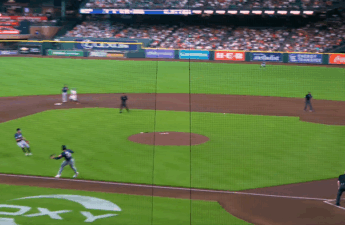I spent the weekend in Lerner Hall at Columbia University. Lerner Hall is this gargantuan glass building that you wouldn’t forget if you’d ever been there – there are basically no strict right angles in the place, and the initial impression one gets of it is akin to being at sea or perhaps down the rabbit hole. Long ramps ring the entire main five-story lobby, occasionally cut-away by Escherian staircases while diagonal rooms of glass and stainless steel offer a disorienting place to work, study, and play. Imagine Hogwarts’ path to the Gryffindor common room with all the moving pictures replaced with glass and all the the wood replaced with shiny metal.
Lerner Hall is one of the all-time Significant places in my life. It was the site of the 9/11 vigil at Columbia Novice on September 14, 2001, the one that more or less created the last ten years of my life. On September 15th, after the all-night talk in Tom’s Restaurant, it’s where Emily and I wandered and chatted and eventually admitted that we were each afraid the other would get sick of us after 10, 12, 16 straight hours of talking, where it first occurred to me that I would tell our unborn daughter that falling in love is just having a conversation that you never want to end. I would be sugarcoating things if I said that I never once looked over the high fifth-floor balcony and contemplated what Em and I finally said to each other on September 24, 2001 and thought about poetry and the full view of history. But I’m still here. And the nice thing about poetic opportunities like that when they are bypassed is that it puts a certain caliber of pressure and significance on the act that is hard to run across in future. But it also makes one think altogether too much about possible worlds.
I was in Lerner to help run a debate tournament, of course, my relationship with the Columbia team roughly diametric to that with the team that helped make Columbia 2003 the all-time Dirt Standard of poorly-run contests. It’s nice to be on the beautiful urban fortress campus and feel an affinity for its denizens that contrasts so highly with the prior impressions I had in an epoch that feels mostly like it happened to someone else, at least when I’m not passing certain crosswise benches in Lerner Hall. The weekend was ultimately long and disjointed, despite being highly productive I was in a turbo-overworked mood that mixed poorly with the filter of memories made so indelible by the glass casing of a building that hasn’t changed in a decade. I felt disconnected from my own team and came to the point of contemplating how much I’m going to help run other tournaments, how much more I ought focus at these competitions on merely maximizing our own morale. Still, I had fun at times and things went well, so like everything these days, there were highs and lows.
There has been a huge kerfuffle of late of the changes made to Facebook and Mark Zuckerberg’s constant drive to open the doors of what is possible in connection on the Internet. And it’s taken me a week of meditation on it to realize that what’s wrong with the web is exactly parallel to what’s wrong with Lerner Hall for me.
The Internet is an ever-changing, ever-evolving universe. There are no constants, no rules, no expectations of consistency. There is a thin under-layer of HTML and protocol that serves as the barest of physical laws to govern an otherwise completely dynamic environment. And since it’s constantly in flux, since it alters itself every nanosecond of every 24 hours of every eternal day, there’s the constant drive to keep changing or get left behind. It is this that drove the rise of Facebook, but also the plunge of Facebook into its current sudden state of overshared disarray. It is this that drove the rise of Google, but also Google’s own descent into irrelevant distrust of the words that a person has actually typed and the barrage of over-sponsored information atop the page. And I’ve realized that the Internet’s lack of buildings is exactly what will make it a landscape where what is right and what works is never constant.
I have long lamented that the Golden Age of Blogging was fleeting and is now merely a wispy memory that current generations barely believed. When I was in college, it seemed inevitable that everyone would blog, improving their creative expression and ability to connect and engage with their peers in a format that one could digest, internalize, and interact with at ongoing leisure. It was a world that, needless to say, I embraced wholeheartedly, a world I still try to pretend exists through avenues like what you’re reading at this moment despite my awareness that blogging is now almost entirely a political vehicle or an extension of capitalism. The personal blog is not dead, but it is badly wounded, careening around the wake of its injury like a moaning quadruped mammal. Most people find blog content too long to read, too un-instantaneous to care about. It has been replaced by Facebook.
But Facebook itself already seems obviously on the decline in the wake of its bifurcation of tickers and adaptation to the “innovative” pressure placed on it by Google+. Rather than trusting in the security of a system that had worked to build the largest single network of human beings in the history of the species, Zucky and friends decided to chase the dragon of a competitor’s suggested alterations and are on the verge of destroying their own genius in the name of constant change. Not to mention they are doing so in pursuit of a competitor that already ruined their own best offering with tools like auto-complete, constant spelling correction that makes searching for a name like “Storey” almost impossible, and individualization of the algorithm that sacrificed knowledge and connection for the sake of something like solipsism and the insulation of everyone’s personal bubble.
How can this happen? Precisely because there is no glass online. There are no beams of stainless steel, no walls of brick or blocks of stone or columns of poured concrete. There is only the ether, the crackle of invisible waves that circulate globally to express an unceasingly instatic reality.
When one builds a building, one plans it. One designs it. One knows that even in the worst of scenarios, this building must stand for years. Most buildings are designed to last decades and centuries, some for a theoretical perpetuity. There is a mentality innate to that undertaking and a reality to engage for those maintaining those structures thereafter. You can’t simply change the underlying support structure of a house, a dorm building, a hall on an ancient campus. You have to deal with the physical realities, the unmovable objects, the blocking and layout and blueprints of bygone architects.
This has a lot of drawbacks. 85% of people are mailing it in at all times and some of them are inevitably engineers. But when it works, when it cobbles together to create something viable, the results are bordering on the eternal. We all can picture the Eiffel Tower (ironically designed to be impermanent, of course), the Taj Mahal, the Pyramids, the Empire State Building. These places, buildings and bridges, the output of human capacity for design and creativity, stand the test of time because they have to. But there is nothing on the Internet that carries this weight, this constancy, this static nature. And while critics of my conceptualization here might raise screenshots of the 1994 web and ask if we’d always want to be stuck there, this is like pointing to the first huts and cave dwellings and asking us to stay there forever too. Just because some early buildings are ugly or fail does not mean that all buildings innately ought be impermanent and subject to alteration. We would never accept someone adding a few floors to the Empire State Building, redressing the Statue of Liberty, knocking the glass out of the Notre Dame. And similarly, we should demand a certain consistency from what works best on the Internet if we are not doomed to writhe in the nostalgic quicksand of only fleeting success.
There is, it occurs to me, a model for this inconstant wrestling, this deliberately impermanent environment. You guessed it folks, it’s capitalism. There are almost no companies that survive even a hundred years, and those that make it that long have reinvented or reimagined themselves so thoroughly that they carry only the barest nominal trappings of their prior incarnations. You can call this innovation and evolution if you want, but it’s more that the nature of the corporate thresher is fickle, demanding, cutthroat, and prone to exterminating things. The core reason for this is the completely irrational demand for constant growth, the bizarre expectation that stability and constancy are the enemy in the face of carcinogenic consumption. Capitalism goes one step beyond sharks’ need to always move and demands that this movement carries eternal expansion as well. In a fixed universe, or at least a fixed planet, this means that beings are constantly unsound and unstable and doomed to fail at an effort whose very premise is flawed from the outset. The nature of the corporate landscape is far more Internet than college campus, institutions mere fleeting tools for the purpose of constant random change.
Which brings us back to Lerner Hall and the contemplation of the failure of all that was supposed to be constant in my own life. Is it coincidence that the rise of the capitalist worldview has corresponded so closely to the rise in divorce rates? Is it random that the Internet’s advent has, in bringing us closer together, also raised the demand for an unending change in partners, living arrangements, extolling the self over permanent connections? I submit to you that these are almost directly correlated. That in espousing a perspective where nothing can reliably be unchanging, our very view of the bonds and pacts people make with each other has also slipped into fungibility. I have said at times that change is the only constant, that there is incredible flux in our universe beyond our very comprehension and thus that traditional ideas of stability are illusory. But at the same time, the middle-ground permanence of a building, of fixed angles and supports and walls, this seems like it might not be too much to hope for. But if our model is to be corporations who constantly eat each other to survive, a landscape of a brutal ocean or savannah of unending danger and consumption, what hope do any of us have of carving out a life for ourselves that can be trusted and thus provide a platform for fulfillment?
Come back to me. Come back to Lerner Hall. The bench is still here.


